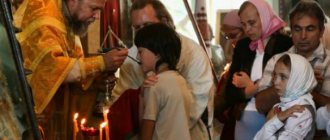Baptism is an important event in the life of every person. It is important for any parent to know how the baptism ceremony takes place. In this article you will learn what significance baptism has in a person’s life, what rules must be followed during the ceremony, and how the baptism of a child and an adult takes place.
The meaning of the ritual
Almost every person who comes into worldly life eventually comprehends spiritual life. Faith in God helps a person throughout his life. The essence of the baptismal ritual is to become closer to the Lord, receive his blessing and join the church. People call the church rite of baptism the second birth of a person.
The most important attribute in the ritual is water, since it is capable of washing away all sins from a person and resurrecting Christ. Therefore, after the ceremony, a person can attend church, confess or receive communion.
Previously, the baptism ceremony was carried out only for adults. Then people believed that a person should consciously approach the choice - to be baptized or not. Now such responsibility lies with the parents. If you wish, you can wait for the child to choose whether to be baptized or not. But the sooner people submit to the rite of baptism, the sooner the Lord will protect them. Therefore, parents today are concerned about the question of how the rite of Orthodox baptism takes place.
Have you undergone baptism?
Not really
Rules of the ritual
Before telling how the baptism ceremony takes place, you need to familiarize yourself with the rules of baptism in Orthodoxy. Employees of the church where the baptism ceremony will take place must inform you what you need to have with you. But we remind you once again that the child needs to prepare the following things:
- baptismal shirt;
- cap for girls;
- diaper;
- pectoral cross;
- an icon of the saint whose name will be said personally in the church.
The shirt and cap must first be blessed in the temple. You can use any white item instead of a shirt. A diaper is needed to wrap the baby.
Particular attention should be paid to the cross. You can buy it in any store, but it is better to do it in a church, because there it will already be consecrated.
It is also worth paying attention to the choice of godmother and father, who should be responsible for the spiritual peace of the baby during the ceremony, as well as take an active part in the child’s life. You need to carefully choose these people, because in the event of the death of the real parents, they are obliged to take care of the child. It is also important that godmothers be baptized.
What if a person lived righteously and fulfilled the commandments in deeds - perhaps without even knowing that they were Christian?
The Church does not pass judgment on such people, leaving them to God’s judgment. The parable of the Last Judgment, which the Lord told his disciples shortly before His death, leaves hope of salvation for those who did not know Christ Himself, but fulfilled His commandments in deed: feeding the hungry, visiting the sick, clothing the poor - in a word, giving themselves to their neighbors. At the Last Judgment, these righteous people ask Christ: Lord! when did we see you hungry and feed you? or to the thirsty and gave them something to drink? when did we see you as a stranger and accept you? or naked and clothed? When did we see You sick, or in prison, and came to You? And the King will answer them: Truly I say to you, just as you did it to one of the least of these brothers of Mine, you did it to Me (Matthew 25: 37-40). Of course, this does not mean that these people will be saved outside the Church. It’s just that the Lord Jesus Christ is the Head of the Church, He can introduce any person into His Church in a way known to Him, and not only through the sacrament of baptism.
The Old Testament righteous people who lived before Christ - Noah, Abraham, Moses, David - did not receive baptism, however, the Church honors them as saints. However, for people living in the Christian era, when the Gospel is available to everyone, the demand is obviously completely different. Therefore, it hardly makes sense to spend a lot of time and effort discussing the fate of the unbaptized righteous - as if our own fate is completely clear. Let us repeat once again: the fact of baptism in itself does not make a person an angelic being; a person still has a long and painful struggle with sin, falling and rising again, building his life in accordance with the Gospel. Therefore, the advice of the Apostle Paul remains relevant for us: Each of us will give an account to God for ourselves. Let us no longer judge each other, but rather judge how not to give your brother any chance of stumbling or temptation (Rom. 14: 12,13).
What is prohibited
There are no prohibitions regarding the age of a person, when one can or cannot be baptized. But the church still advises doing this as early as possible in order to be cleansed of original sin.
Until the age of 7, parents decide for their child whether to baptize him or not. From 7 to 14 years of age, the child’s consent will be required. But after turning 14 years old, the child himself has the right to decide whether to be baptized or not.
The bans exist for 40 days after the birth of the child. It is believed that at this time the mother cannot enter the church because she is unclean. In some cases, for example, with congenital diseases, the priest may baptize the child a few days after birth.
It is also prohibited for women - mothers and godmothers - to have their periods during the ceremony.
Salvation from what is promised to those who believe and are baptized?
Firstly, from slavery to sin, when, in the words of the Apostle Paul, I do not do what I want, but what I hate, I do (Rom 7:15 ). Secondly, from slavery to Satan, who through deception and slander against God provoked the fall of Adam and his wife. Thirdly, from death, which subjugated the whole world as a result of the Fall of man.
But salvation in Orthodox Christianity is not only called liberation from these three types of slavery. Salvation is the ultimate rapprochement and entry into a filial relationship with God, the achievement of unity with God, the acquisition of that Kingdom of Heaven, where God will be all in all (1 Cor 15:28 ). Christ himself calls salvation eternal life, about which we can still say little, except that it will be unimaginably beautiful, joyful and, in the words of Metropolitan Anthony of Sourozh, overflowing from excess fullness. As the Apostle Paul wrote about this, eye has not seen, ear has not heard, and what God has prepared for those who love Him has not entered into the heart of man (1 Cor 2 :9).
How does the baptism ceremony of a child take place?
Before the rite of Orthodox baptism of a child, the name of a saint is chosen - this will be the church name of the child. If such a name is not among the saints, the priest chooses one that is consonant with the child’s name. If this does not happen, then they name it after the saint who is revered on the child’s birthday.
Now that you have learned about all the rules and prohibitions of the baptismal ceremony, you can understand the most important thing - how the ceremony takes place. There are several stages of the Christian rite of baptism, and we will understand each of them.
Announcement
This is the very first stage and one of the important ones in the ritual. The priest reads special prayers over the child, which are directed against sins and devils. He then blows on the child's face to show how God created man and breathed life into him. The next prayer is said simultaneously with the priest’s hand on the baby’s head. This prayer blesses a person and protects him from sins.
Renunciation of the devil and communion with Christ
At this stage, his godparents interact with the child. They must read a prayer for a person to renounce the devil, because a small child is unable to do this. After this stage, the child goes over to God’s side, renounces sins and agrees to lead a spiritual life.
Also during this stage, communion with Christ occurs, because it is very difficult to fight the devils on your own. The godparents also read out a prayer that they learned in advance.
The child's baptism itself
The Christian rite of baptism takes place with the help of holy water - a symbol of human life. Also an important attribute is a special oil, which symbolizes healing and joy. A child is baptized with it, it is applied all over the body and in the water.
Next comes the immersion of the child in the water itself. The procedure occurs three times - the number of days it took the Lord to resurrect. At the same time, the clergyman reads a prayer.
Then the child is handed over to the godmother or godfather, depending on the gender of the baby. They wrap the baby up and put on the baptismal robe. This is how the baby gets rid of all sins.
Confirmation
The special oil represents the gift of the Holy Spirit and is prepared once a year. Special consecrated oil is smeared on the child’s forehead, lips, arms, legs and chest. This is how the body and soul of a person are sanctified.
Churching
These are the final stages in the process of how the baptism ceremony takes place. The baptized person walks around in a circle, during which the priest reads prayers. The godparents hold candles at this time.
Next, the priest washes off the oil from the child’s body, showing that only internal forces can help a person. The priest then cuts off a lock of the child's hair, which symbolizes the sacrifice.
But in order to be born again, you must first die... Isn't it?
Baptism, according to the Apostle Paul, is the experience of death and birth, in the likeness of the death and resurrection of the Lord Jesus Christ. Do you not know that all of us who were baptized into Christ Jesus were baptized into His death? - he writes in the Epistle to the Romans. - We were buried with Him through baptism into death, so that just as Christ was raised from the dead by the glory of the Father, so we too might walk in newness of life. For if we are united with Him in the likeness of His death, we must also be united in the likeness of His resurrection... If we died with Christ, then we believe that we will also live with Him (Rom. 6: 3-5, 8).
Of course, in the baptismal font a person does not die and is not resurrected physically - we are not talking about biological death or physical resuscitation. But we are not talking about any conventional, symbolic things or artistic metaphors. Everything that happens in the sacrament happens in reality, but concerns primarily the spiritual side of the personality. A person emerges from the baptismal waters spiritually reborn: he is ready to begin his spiritual life path anew, something like a spiritual “reset” occurs.
Baptism of Rus'. IN AND. Navozov
In any sacrament - and in baptism the first of them - a person encounters the action of God, which Christians call grace, a good gift. In baptism, this gracious action of God consists in the fact that a person is freed from slavery to sinful inclinations, from “bad heredity” received from Adam. Now he is able to resist sinful habits and desires, because from now on he has a new relationship - no longer with the old Adam, but with the new one, with the God-man Jesus Christ. A baptized person becomes a member of the Church - the community of believers in Christ, which the Apostle Paul calls the body of Christ. In this way, he is united with Christ - the Son of Man, and since Christ is at the same time the Son of God, then the baptized person is adopted by God the Father and becomes able to live one life with Him - that same eternal and joyful life of the Kingdom of Heaven. From now on, he is no longer just a creation of God, but His own son or daughter - and therefore everything that the Father has belongs to both him and her.
The Apostle Paul writes about it this way: Consider yourselves dead to sin, but alive to God in Christ Jesus our Lord (Rom 6:11 ). In the words of the Apostle Paul, the old man dies. And a new man is born, endowed, as Protopresbyter Alexander Schmemann wrote, with the gift of living the life of Christ Himself, believing Him by faith, desiring what He desires.
Supported by the gift of grace received in baptism, a person is able to actually move towards the Kingdom of Heaven, which in practice means fulfilling the commandments of Christ: overcoming one’s own selfishness, transcending the demands of one’s “I” and putting God and one’s neighbor first. A baptized person is able to live contrary to the rules that have become “natural” for this world since the Fall. And he may truly want that life - life not for himself, but for God, which Christ offers him and the continuation of which is the Kingdom of God. But an unbaptized person does not have the strength for all this. They simply have nowhere to come from.
Baptism ceremony for an adult
The baptism ceremony for an adult is the same as for a child. But there are several features. Firstly, after 18 years of age a person does not need the help of godparents. Secondly, the main rule for performing a ritual for an adult is faith in God. It is when a person accepts faith that he can be baptized.
An adult who wants to undergo baptism must talk to a priest and learn about the responsibilities of an Orthodox person. After he receives all the answers to his questions, he will definitely decide for himself whether he needs to be baptized or not. If the answer is yes, then the person must prepare for the ceremony. You should take:
- shirt and slippers;
- cross;
- towel;
- candles.
The baptism ceremony for an adult is the same as for a child. But women need to take into account that a wet shirt can be see-through, so you can wear underwear or a swimsuit underneath.
Let's sum it up
Baptism is the second birth of a person. In the early years, everything depends on the parents - whether they want to baptize their child or not. In adulthood, a person can decide for himself whether to believe in God or not. But the sooner the rite of baptism occurs, the better a person will unite with God. The ceremony can be performed in any Orthodox church
From an early age, children need to be instilled with the love of God. You need to read prayers, attend churches, go to confession, and instill faith in God in the child (but not by force!). Show your child that the Divine is all around us and manifests itself in all areas of the world around us.
Share the article on social networks! :










